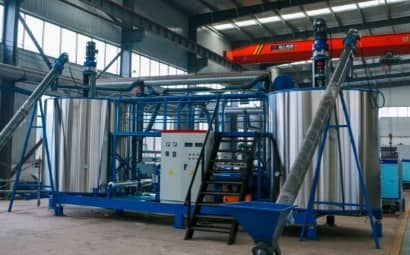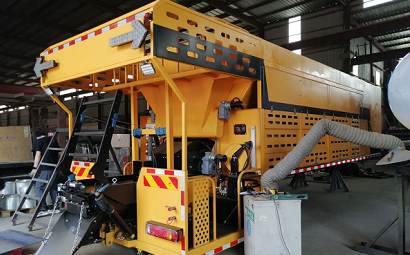Micro-surfacing is a preventive maintenance technology that uses a certain grade of stone chips or sand, fillers (cement, lime, fly ash, stone powder, etc.) and polymer-modified emulsified asphalt, external admixtures and water in a certain proportion. Mix it into a flowable mixture and then evenly spread it over the sealing layer on the road surface.


Analysis of pavement structure and causes of pavement diseases
(1) Control of raw material quality
During the construction process, the control of raw materials (coarse aggregate diabase, fine aggregate diabase powder, modified emulsified asphalt) starts with the entry materials provided by the supplier, so the materials provided by the supplier must There is a formal test report. Furthermore, the materials are comprehensively inspected in accordance with relevant standards. During the construction process, the quality of the raw materials must also be analyzed. If there is any doubt, the quality must be randomly checked. In addition, if changes in raw materials are found, the imported materials must be re-tested.
(2) Control of slurry consistency
In the process of proportioning, the water design of the slurry mixture has been determined. However, according to the influence of the humidity on site, the moisture content of the aggregate, the temperature of the environment, the moisture content of the road, etc., the site often needs to adjust the slurry according to the actual situation. The amount of water used in the slurry mix is ??adjusted slightly to maintain the consistency of the mix suitable for paving needs.
(3) Micro-surface demulsification time control
During the highway micro-surfacing construction process, an important reason for quality problems is that the demulsification time of the slurry mixture is too early.
The uneven thickness, scratches, and disunity of asphalt caused by demulsification are all caused by premature demulsification. In terms of the bond between the sealing layer and the road surface, premature demulsification will also be very detrimental to it.
If it is found that the mixture is demulsified prematurely, an appropriate amount of retarder should be added to change the dosage of the filler. And turn on the pre-wet water switch to control the breaking time.
(4) Control of segregation
During the paving process of highways, segregation occurs due to reasons such as thin paving thickness, thick mixture gradation, and marking line position (smooth and with a certain thickness).
During the paving process, it is necessary to control the paving thickness, measure the paving thickness in time, and make timely adjustments if any deficiencies are found. If the gradation of the mixture is too coarse, the gradation of the slurry mixture should be adjusted within the gradation range to improve the segregation phenomenon at the micro surface. At the same time, the road markings to be paved should be milled before paving.
(5) Control of road paving thickness
In the paving process of highways, the paving thickness of thinner mixture is about 0.95 to 1.25 times. In the grading range, the curve should also be closer to the thicker side.
When the proportion of large aggregates in the aggregate is large, it must be laid thicker, otherwise the large aggregates cannot be pressed into the sealing layer. Moreover, it is also easy to cause scratches on the scraper.
On the contrary, if the aggregate is fine during the proportioning process, then the paved road surface must be paved thinner during the paving process of the highway.
During the construction process, the thickness of the paving must also be controlled and tested to ensure the amount of slurry mixture used in highway paving. In addition, during inspection, a vernier caliper can be used to directly measure the slurry seal on the micro-surface of the newly paved highway. If it exceeds a certain thickness, the paver box must be adjusted.
(6) Control of highway appearance
For micro-surface paving on highways, the structural strength of the road surface must be tested in advance. If looseness, waves, weakness, potholes, slurry, and cracks appear, these road conditions must be repaired before sealing construction.
During the paving process, be sure to keep it straight and ensure that the curbs or roadsides are parallel. In addition, when paving, the paving width should also be ensured, and the joints should be placed as far as possible on the lane dividing line to control the stability of the mixing and prevent the materials from prematurely separating in the paving box to ensure that they are The amount of water during the process is even and moderate.
In addition, all materials must be screened during loading to remove oversized particles, and defects must be smoothed in time during the filling process to keep their appearance smooth and consistent.
(7) Control of traffic opening
The shoe mark test is a commonly used inspection method for highway opening quality during micro-surface highway maintenance. That is to say, put the person's weight on the root or bottom of a shoe and stand on the sealing layer for two seconds. If the aggregate is not brought out or stuck to the person's shoe when leaving the sealing layer surface, it can be considered as micro surface. After the maintenance work is completed, it can be opened to traffic.
 Albanian
Albanian  Russian
Russian  Arabic
Arabic  Amharic
Amharic  Azerbaijani
Azerbaijani  Irish
Irish  Estonian
Estonian  Odia (Oriya)
Odia (Oriya)  Basque
Basque  Belarusian
Belarusian  Bulgarian
Bulgarian  Icelandic
Icelandic  Polish
Polish  Bosnian
Bosnian  Persian
Persian  Afrikaans
Afrikaans  Tatar
Tatar  Danish
Danish  German
German  French
French  Filipino
Filipino  Finnish
Finnish  Frisian
Frisian  Khmer
Khmer  Georgian
Georgian  Gujarati
Gujarati  Kazakh
Kazakh  Haitian Creole
Haitian Creole  Korean
Korean  Hausa
Hausa  Dutch
Dutch  Kyrgyz
Kyrgyz  Galician
Galician  Catalan
Catalan  Czech
Czech  Kannada
Kannada  Corsican
Corsican  Croatian
Croatian  Kurdish (Kurmanji)
Kurdish (Kurmanji)  Latin
Latin  Latvian
Latvian  Lao
Lao  Lithuanian
Lithuanian  Luxembourgish
Luxembourgish  Kinyarwanda
Kinyarwanda  Romanian
Romanian  Malagasy
Malagasy  Maltese
Maltese  Marathi
Marathi  Malayalam
Malayalam  Malay
Malay  Macedonian
Macedonian  Maori
Maori  Mongolian
Mongolian  Bengali
Bengali  Myanmar (Burmese)
Myanmar (Burmese)  Hmong
Hmong  Xhosa
Xhosa  Zulu
Zulu  Nepali
Nepali  Norwegian
Norwegian  Punjabi
Punjabi  Portuguese
Portuguese  Pashto
Pashto  Chichewa
Chichewa  Japanese
Japanese  Swedish
Swedish  Samoan
Samoan  Serbian
Serbian  Sesotho
Sesotho  Sinhala
Sinhala  Esperanto
Esperanto  Slovak
Slovak  Slovenian
Slovenian  Swahili
Swahili  Scots Gaelic
Scots Gaelic  Cebuano
Cebuano  Somali
Somali  Tajik
Tajik  Telugu
Telugu  Tamil
Tamil  Thai
Thai  Turkish
Turkish  Turkmen
Turkmen  Welsh
Welsh  Uyghur
Uyghur  Urdu
Urdu  Ukrainian
Ukrainian  Uzbek
Uzbek  Spanish
Spanish  Hebrew
Hebrew  Greek
Greek  Hawaiian
Hawaiian  Sindhi
Sindhi  Hungarian
Hungarian  Shona
Shona  Armenian
Armenian  Igbo
Igbo  Italian
Italian  Yiddish
Yiddish  Hindi
Hindi  Sundanese
Sundanese  Indonesian
Indonesian  Javanese
Javanese  Yoruba
Yoruba  Vietnamese
Vietnamese  Hebrew
Hebrew  Chinese (Simplified)
Chinese (Simplified)







